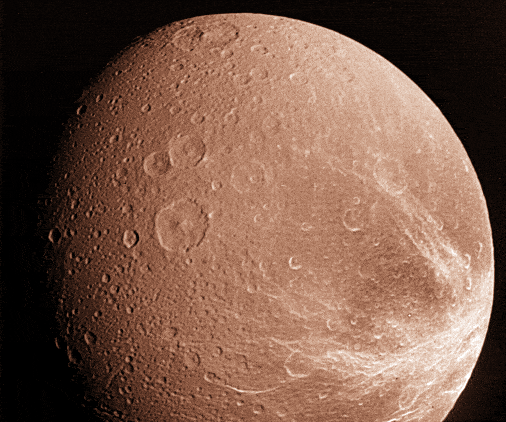It’s been less than a month since we published the last thing about the Cassini probe, and the amazing spacecraft has done it again; this time it detected a thin, oxygen atmosphere, on a moon of Saturn – Dione. The study was published in the Geophysical Research Letters
At 1122 km in diameter, Dione is the 15th largest moon, and the last significant one – larger than all the rest of the planet’s moons put together. Since its formation, Dione has definitely undergone some interesting geological processes, as pictures shown again by Cassini in 2004 revealed what are believed to be ice cliffs created by tectonic fractures, hundreds of meters tall or even more. Some believe that ice volcanism also played a role in the process of shaping the planet.
Now, more recently, the Cassini probe signaled the existence of an oxygen atmosphere in the planet, but don’t get too excited about moving there: the atmosphere is three trillion times thinner than on the surface of Earth – pretty much what you’d expect to see some 300 km above ground here. Still, that’s enough to classify it as an atmosphere, and astronomers are pretty excited about this find, not necessarily in itself, but in the implications it carries.
We now know that Dione, in addition to Saturn’s rings and the moon Rhea, is a source of oxygen molecules,” Cassini team member Robert Tokar of the Los Alamos National Laboratory in New Mexico, who led the new study, said in a statement. “This shows that molecular oxygen is actually common in the Saturn system and reinforces that it can come from a process that doesn’t involve life.”
The oxygen on Dione may be created by solar photons or high-energy particles that bombard the moon’s icy surface, kicking up oxygen atoms in the process. Another theory is that the previous geological events supplied the necessary oxygen for this atmosphere. Either way, this discovery came as quite a shock to many.
“Scientists weren’t even sure Dione would be big enough to hang on to an exosphere, but this new research shows that Dione is even more interesting than we previously thought,” said Amanda Hendrix, the deputy project scientist for Cassini at NASA’s Jet Propulsion Laboratory, Pasadena, Calif., who did not participate in Tokar’s study. “Scientists are now digging through Cassini data on Dione to look at this moon in more detail.”



